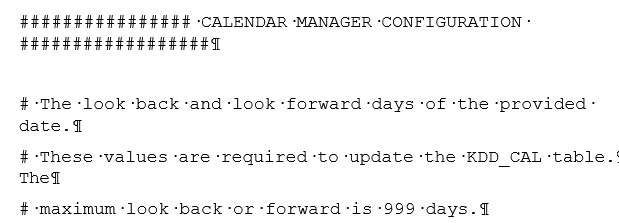8.5.4.1 Configuring the Calendar Manager Utility
The
<INSTALL_DIR>/database/db_tools/mantas_cfg/install.cfg file contains
common configuration information that Calendar Manager and other utilities require for
processing. The following sample section from the install.cfg file provides
configuration information specific to this utility, including default numerical values in
the utility’s two required parameters.
Figure 8-4 Calender Manager Configuration

calendar.lookBack: Determines how many days to iterate backward from the provided date during a calendar update.calendar.lookForward: Determines how many days to iterate forward from the provided date during a calendar update.The maximum value that you can specify for either of these parameters is 999 days.
Note:
The lookback period should be at least 90 days and as long as any alerts are likely to be open. The lookforward period does not must be more than 10 days. This is used when calculating projected settlement dates during Data Ingestion.Caution:
When you have configured the system to calculate alert age in Business Days, the calendar date of the current system date and the calendar date of the alert creation must be included in the calendar.As such, if you are running with a business date that is substantially behind the current system date, you should set the lookForward parameter for the calendar manager sufficiently high to ensure that the system date is included on the calendar.
Additionally, if you have alerts that are open for a very long period, you should set the lookBack parameter sufficiently high to include the dates of your oldest open alerts. If the business calendar does not cover either of these dates, the processing reverts to calculating age in Calendar days.
The utility connects to the database employing the user that the
utils.database.username property specifies in the
install.cfg file.